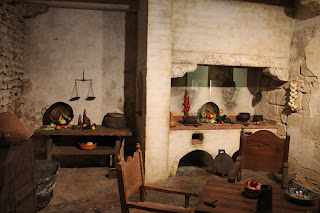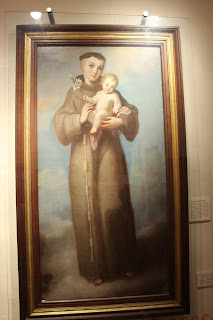Fray Fermin Francisco Lasuén, a Franciscan friar, founded the Mission of Santa Barbara, on December 4th, 1786, the feast day of Saint Barbara, a Christian Virgin at the beginning of the 4th Century, was martyred in Heliopolis, Syria, beheaded by her father, Dioscorus. When the ship that brought Fray Junipero Fray Junipero Serra and a group of Spanish Missionaries in December, 1749, was on the verge of sinking during a storm off the coast of Veracruz, they beseeched the intercession of Saint Barbara, and on December 4th, her Holiday, they arrived safely to port.
Santa Barbara was the first of 9 missions that the Franciscans would establish during a period from 1786 to 1798, during Fermin Francisco Lasuén's tenure as Mission President.
The Franciscans established the Mission of Santa Barbara in order to convert the local Chumash-Barbareno tribes to Christianity and to a more European model of life, in the Mission, with organized agriculture, orchards, granaries, cattle raising and orderly life "under the Mission bell".
Friar Fermin Francisco Lasuén was born in Spain, and came to New Spain in 1759.
Santa Barbara, in 1786, was the first Franciscan Mission in Alta California founded after the demise of Fray Junipero Serra in 1784.
Californians frequently refer to the Santa Barbara Mission as the "Queen of the Missions", alluding quite probably in part to the beauty of the buildings as well as the natural surroundings.
If you think that here you are seeing the Santa Barbara Mission just as Fray Fermin Lasuén built it, you are in for a disappointment. What you see here is a beautiful fountain, finished in 1808, well after Fray Fermin's death.
The Church built three times with adobe brick, from 1786 up into the first decade of the 19th Century, only to be destroyed in the 1812 earthquake. So the church behind me, was dedicated in 1820, ironically the year that this territory, the Alta California of New Spain, no longer belonged to Spain. This is not the only difference. If you take a close look at the façade, you will realize that it has incorporated some of the "neo-classical" style that became popular in Mexico City during the last years of the 18th century, substituting the baroque style more common in the earlier Missions.
Mission Santa Barbara was hit again by a devastating earthquake again on June 29th, 1925, with severe damage not only in the monastery, but in the Church as well, especially to both domes of the bell towers.
Here is washing basin used by the community to wash their clothes, and possibly the linens used in the celebration of the Liturgy.
Washing clothes was a predominantly female activity in the 18th and 19th centuries, both in Europe as in New Spain, an activity in which women would gather together and talk with their friends, and probably partake in a good deal of local gossip. So many times when I travel with my family, especially in the southern regions of what now is Mexico, we drive over bridges, and along the river beds, we see women partaking even today in this routine of clothes washing in the river, which might even conceivably have origins in the customs of the Mesoamerican peoples.
When I first saw this structure, I mistook it for a "troje" or trowel for the horses and cattle to come and drink.
The Chumash Indians were basically hunters until the Santa Barbara Mission was established. Under the guidance of the Franciscans they built an irrigation system for the farms, consisting of a dam, an aqueduct, and channels. Soon they were harvesting wheat, barley, corn, beans, peas, oranges, olives and grapes.
The Cloister Garden was once a patio where the
Franciscan Friars taught different trades to the
Chamash.
The Franciscans not only planted Palm trees in
the Cloister Garden, but also the "Bird of Paradise"
plant and flower.
A fountain is the center of the Cloister Garden
Main altar of the Church of the Santa Barbara
Mission
This portrait shows us the two
last of the Glorious Mysteries of
the Holy Rosary: The Blessed
Virgin's Assumption into Heaven
and Her Coronation as Queen of
Heaven. The painting is attributed
to the school of Spanish Painter
Murillo.
On the opposite wall, is a portrait
of Mary, the Mother of Christ,
Mary Magdalene and John the
Apostle
The portrait of Our Lady of
Guadalupe
During our visit to Mission Santa Barbara one of
the side chapels was undergoing restoration
Jesus with Mary Magdalene
Saint Francis and Saint Clair
Founders of the Franciscans and
the Sisters of Saint Clair
These diagrams show the blueprints of the four
Churches that were built, one after another, on
the same site, at the Santa Barbara Mission.
Estela studies one of the original Mission bells
in the Mission Museum with pictures showing
where the bells were placed in the towers
As early as the 16th century, corded instruments
were used in religious concerts. However the
Council of Trent limited instruments in Liturgy
basically to the Organ.
Here is a sample of a Hymn in Latin to be sung
in the style of Gregorian Chant, if we only take
into account the notes in black. However, it is
possible, that this Hymn was modified by the
Choir master to Polyphonic style, taking into
account the notes in red.
Here is a graphic illustration of
Mary interceding for Souls in
Purgatory
A small refectory as used by the
Franciscan Friars in Missions
like Santa Barbara at the end of
the18th Century
The Life in Community, with a refectory, as well
as a chapel is an essential part of the life of a
Franciscan, or of any Mendicant Order.
Eventually scientific instruments
were incorporated into the school
or the Mission, such as the
telescope in the above picture.
Lamps and candle holders made
in the mission by the blacksmith
The blacksmith was one of the
first "oficios" or trades that the
Franciscans needed to establish
in a new Mission to make it
sustainable.
The blacksmith shop produced
knives, tools, keys, locks, and
lamps for the Mission, besides
making horseshoes.
Juana Maria was a native woman
that was kidnapped from the
Chumash by pirates, and
abandoned on a deserted island
for many years.
Saint Bonaventure
Saint Francis of Assisi at Prayer
Saint Anthony of Padua with
Infant Jesus.
Saint Barbara is the only one of the original 18th Century Missions that has always been kept in continuous and uninterrupted functions, under the continuous supervision of the Franciscan Friars for over 230 years.
Moreton Bay Fig tree in the back
yard of the Mission. This type of
Fig tree comes from Australia,
and was planted here in 1910.
Entrance to Mission Cemetery.






























































